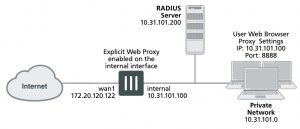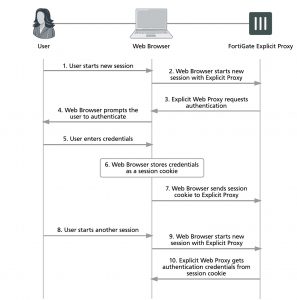The FortiGate explicit FTP proxy
You can use the FortiGate explicit FTP proxy to enable explicit FTP proxying on one or more FortiGate interfaces. The explicit web and FTP proxies can be operating at the same time on the same or on different FortiGate interfaces.
Explicit FTP proxies are configured for each VDOM when multiple VDOMs are enabled.
In most cases you would configure the explicit FTP proxy for users on a network by enabling the explicit FTP proxy on the FortiGate interface connected to that network. Users on the network would connect to and authenticate with the explicit FTP proxy before connecting to an FTP server. In this case the IP address of the explicit FTP proxy is the IP address of the FortiGate interface on which the explicit FTP proxy is enabled.
Enabling the explicit FTP proxy on an interface connected to the Internet is a security risk because anyone on the Internet who finds the proxy could use it to hide their source address.
If the FortiGate unit is operating in Transparent mode, users would configure their browsers to use a proxy server with the FortiGate unit management IP address.
The FTP proxy receives FTP sessions to be proxied at FortiGate interfaces with the explicit FTP proxy enabled. The FTP proxy uses FortiGate routing to route sessions through the FortiGate unit to a destination interface. Before a session leaves the exiting interface, the explicit FTP proxy changes the source addresses of the session packets to the IP address of the exiting interface. When the FortiGate unit is operating in Transparent mode the explicit web proxy changes the source addresses to the management IP address.
Example explicit FTP proxy topology
To allow anyone to anonymously log into explicit FTP proxy and connect to any FTP server you can set the explicit FTP proxy default firewall proxy action to accept. When you do this, users can log into the explicit FTP proxy with any username and password.
In most cases you would want to use explicit proxy policies to control explicit FTP proxy traffic and apply security features, access control/authentication, and logging. You can do this by keeping the default explicit FTP proxy firewall policy action to deny and then adding explicit FTP proxy policies. In most cases you would also want users to authenticate with the explicit FTP proxy. By default an anonymous FTP login is required. Usually you would add authentication to explicit FTP proxy policies. Users can then authenticate with the explicit FTP proxy according to users or user groups added to the policies. User groups added to explicit FTP proxy policies can use any authentication method supported by FortiOS including the local user database and RADIUS and other remote servers.
If you leave the default firewall policy action set to deny and add explicit FTP proxy policies, all connections to the explicit FTP proxy must match an or else they will be dropped. Sessions that are accepted are processed according to the ftp-proxy security policy settings.
You can also change the explicit FTP proxy default firewall policy action to accept and add explicit FTP proxy policies. If you do this, sessions that match explicit FTP proxy policies are processed according to the policy settings. Connections to the explicit FTP proxy that do not match an explicit FTP proxy policy are allowed and the users can authenticate with the proxy anonymously.
There are some limitations to the security features that can be applied to explicit FTP proxy sessions. See Security profiles, threat weight, device identification, and the explicit FTP proxy on page 2938.
You cannot configure IPsec, SSL VPN, or Traffic shaping for explicit FTP proxy traffic. Explicit FTP proxy policies can only include firewall addresses not assigned to a FortiGate unit interface or with interface set to any. (On the web-based manager you must set the interface to Any. In the CLI you must unset the associated- interface.)
Having trouble configuring your Fortinet hardware or have some questions you need answered? Check Out The Fortinet Guru Youtube Channel! Want someone else to deal with it for you? Get some consulting from Fortinet GURU!



